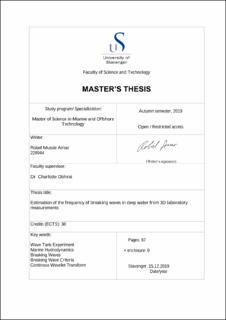| dc.contributor.advisor | Obhrai, Charlotte | |
| dc.contributor.author | Amar, Robel Mussie | |
| dc.date.accessioned | 2021-03-01T13:45:18Z | |
| dc.date.available | 2021-03-01T13:45:18Z | |
| dc.date.issued | 2019-12 | |
| dc.identifier.uri | https://hdl.handle.net/11250/2730971 | |
| dc.description | Master's thesis in Offshore technology | en_US |
| dc.description.abstract | Wave breaking is an essential aspect of the sea surface process. Although being an emerging area of research over the last 50 years, the phenomenon remains to be fully understood due to the erratic behavior of breaking waves. This area of research is of particular interest in offshore engineering as marine structures subjected to the impact of such waves may cause considerable damage and fatigue. In this thesis, I have been become familiar with the state of the art of this field and I have applied different methods in order to detect and estimate the frequency of breaking waves. MATLAB has been used to analyze 20 sets of data describing the surface elevations recorded in a wave tank. All 20 realizations are generated with the properties: Hs = 0.373 m, Tp = 2.75 s. After Froude-scaling, the surface elevation data from the wave tank simulates the recordings of deep-water ocean waves. Four different wave breaking criteria have been applied to analyze the surface elevations: the geometric criterion, the dynamic criterion, the dynamic criterion by use of continuous wavelet transform, and limiting local energy density peak by use of continuous wavelet transform. To assess the accuracy and the occurrence of breaking waves, these four criteria have been evaluated by three performance metrics: the detection rate, which is defined as the ratio of confirmed breaking wave events over wave events fulfilling the criterion; the rate of false positives, which is defined as the ratio of non-breaking wave events over wave events fulfilling the criterion; and frequency of wave breaking, which is defined as the ratio of confirmed breaking events over all wave events in the realization. These performance metrics are computed for every single realization and then averaged. This study finds that the dynamic criterion has the best performance with an average detection rate of 89.8 %, corresponding average rate of false positive of 10.2 %, and an average breaking wave frequency of 3.38 %. It is concluded that the geometric criterion should be discarded as it poorly captures the irregular and non-linear properties of the surface elevation, at least when the wave events are defined as zero-up-crossing. The other methods, including the dynamic criterion, are considered to have great potential and can most possibly be further developed to better detect breaking wave events. | en_US |
| dc.language.iso | eng | en_US |
| dc.publisher | University of Stavanger, Norway | en_US |
| dc.relation.ispartofseries | Masteroppgave/UIS-TN-IMBM/2019; | |
| dc.rights | Navngivelse 4.0 Internasjonal | * |
| dc.rights.uri | http://creativecommons.org/licenses/by/4.0/deed.no | * |
| dc.subject | offshore teknologi | en_US |
| dc.subject | wave tank experiment | en_US |
| dc.subject | marine hydrodynamics | en_US |
| dc.subject | bølgekraft | en_US |
| dc.subject | numerisk analyse | en_US |
| dc.subject | continuous wavelet transform | en_US |
| dc.title | Estimation of the frequency of breaking waves in deep water from 3D laboratory measurements | en_US |
| dc.type | Master thesis | en_US |
| dc.subject.nsi | VDP::Teknologi: 500::Marin teknologi: 580::Offshoreteknologi: 581 | en_US |

